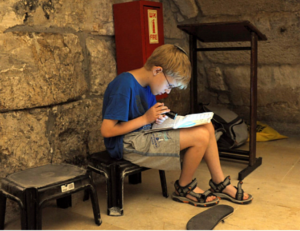Aug 3 Update:
New York Times Corrects
During our ongoing extensive correspondence with the New York Times, editors informed CAMERA it would be correcting the error detailed below. On Aug. 2, the newspaper corrected its piece to clear the record on Judaism's holiest site. See below for a detailed update.
Today marks Tisha B'Av, the solemn fast day mourning the destroyed First and Second Jewish Temples, along with a host of other tragedies which befell the Jewish people on this date. As Jews recite mournful liturgy and observe customs to mark the loss of the two Temples which once stood on Jerusalem's Temple Mount, major Western media outlets continue to engage in misreporting distancing the Jewish people from their most sacred site.

A Jewish boy observers the mourning day of Tisha B'Av, reading from the Kinnot texts, at the Western Wall, July 2012 (Photo by Amos Ben Gershom/GPO)
Thus, The New York Times set the tone earlier this week with a July 25 page-one news analysis (also online here), which erroneously refers to the Western Wall as Judaism's holiest site ("Netanyahu ushers in a precarious new era"). Jerusalem bureau chief Patrick Kingsley errs, referring to "an ultra-Orthodox party that proposed fining women for reading the Torah at the holiest site in Judaism." The proposal in question would have criminalized women reading the Torah at the Western Wall, which is not Judaism's holiest site.
The Temple Mount, not the Western Wall, is Judaism's holiest site, a fact which The Times has rightly noted in the past. (No one is permitted to read the Torah at the Temple Mount, where Jewish prayer is forbidden.) Moreover, a commendable Oct. 22, 2015 New York Times correction stated:
An earlier version of this article referred incorrectly to the Western Wall. It is one of the holiest sites in Judaism, not the holiest site. (The holiest is the Temple Mount.) The error was repeated in a picture caption.
The paper again corrected this point in 2017.
The aptly named Holy of Holies, which the High Priest entered only once a year on the holiest day of Yom Kippur, is on the Temple Mount, and was housed in the two Temples.
But the Temple Mount’s status as Judaism's holiest site predates even the First Temple. According to Jewish tradition, the Even Hashtiya, the foundation stone upon which the world was created, is located on the site. Jews believe that the biblical Abraham brought Isaac to that spot for sacrifice and that the Ark of the Covenant containing the Ten Commandments once stood there, the epicenter of Judaism.
While the Western Wall is the holiest site where Jews are permitted to regularly pray, it derives its holiness from its proximity to the Temple site. Though CAMERA alerted The Times to the error yesterday, a correction has yet to appear as of this writing.
 Reuters, for its part, deployed a different common journalistic trick which obscures the primary sanctity of the Temple Mount in Judaism. Today's article, "Israel's president urges calm amid plans for further protests at judicial overhaul," had selectively reported the Temple Mount/Noble Sanctuary's sanctity in Islam but not Judaism:
Reuters, for its part, deployed a different common journalistic trick which obscures the primary sanctity of the Temple Mount in Judaism. Today's article, "Israel's president urges calm amid plans for further protests at judicial overhaul," had selectively reported the Temple Mount/Noble Sanctuary's sanctity in Islam but not Judaism:
Marking Tisha B'av, Israel's far-right minister for police, Itamar Ben-Gvir, toured the Jerusalem mount that once housed the temples and which is now the site of al-Aqsa mosque, Islam's third-holiest shrine. A past Ben-Gvir visit there set off outrage among Palestinians and the wider Muslim world.
Reuters has previously fixed this uneven reporting when CAMERA flagged it in 2017, as has The New York Times (more than once).
Agence France Presse, another leading news agency, employs yet a third common journalistic misdeed which downplays the deep, unbreakable Jewish connection to the Temple Mount: casting the Temples' location on the Temple Mount as nothing more than a matter of belief.
In "Palestinian militants in West Bank fire rocket at Israeli community," AFP imprecisely reports: "it is believed that both Jewish temples located on the Temple Mount -- currently the site of the Al-Aqsa mosque compound in Israel-annexed Jerusalem -- were destroyed."
That the two Jewish temples were located (and subsequently destroyed) on the Temple Mount is not merely a matter of "belief," it's an archeological fact, a point memorably corrected at The New York Times, as well as at Deutsche Welle, and Reuters, among others.
The Associated Press took a different approach, distancing Jews from their holiest site by falsifying the present as opposed to the past.
 In a tweet (screenshot at left) today promptly and commendably deleted in response to communication from CAMERA's Israel office, the news agency claimed that far-right Israeli Minister Itamar Ben-Gvir "visited a sensitive Jerusalem mosque."
In a tweet (screenshot at left) today promptly and commendably deleted in response to communication from CAMERA's Israel office, the news agency claimed that far-right Israeli Minister Itamar Ben-Gvir "visited a sensitive Jerusalem mosque."
Ben-Gvir visited the Temple Mount plaza, and did not step foot in the Al Aqsa mosque or any other building on the site, remaining outside the entire time.
Given that the Temple Mount, and the mosque in particular, are indeed flashpoints, false claims claiming that Ben-Gvir entered the mosque further inflame.
Moreover, the accompanying AP article doesn't mention that the Temple Mount is Judaism's holiest site until an incredible 16 paragraphs, deep into the story. The fact that the site is Judaism's holiest is highly relevant to any Jewish visit there (whether it be Ariel Sharon, Itamar Ben-Gvir, or any other public or private figure).
How many AP print clients will cut that essential paragraph, given that it is so low down, thereby eliminating information that the site is Judaism's most sacred?
@AP calls the Temple Mount a "mosque," falsely claiming Ben-Gvir "visited a sensitive Jerusalem mosque." We'll add that to @CAMERAorg #TishaBAv count as 4th media method for distancing Jewish people from their most sacred site https://t.co/3zPW5oM4g6 https://t.co/lOGt5ifGSZ
— Tamar Sternthal (@TamarSternthal) July 27, 2023
Update: New York Times Corrects
Following CAMERA's ongoing communication with the New York Times and letters from our readers, the newspaper ultimately agreed a correction was needed and published the following correction:
A correction was made on Aug. 2, 2023: An earlier version of this article referred imprecisely to the holiest site in Judaism. The Temple Mount is considered the holiest site in Judaism; the Western Wall is a remnant of the retaining wall of the ancient temple complex.
We commend the newspaper for clearing the record.
